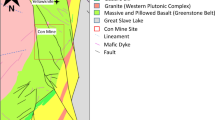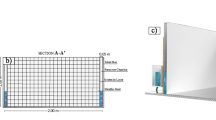Abstract
A numerical model of coupled saturated/unsaturated water flow, heat transfer and multi-component reactive solute transport is presented to evaluate the long-term geochemical evolution in bentonite, concrete and clay formation for a potential geological radioactive waste repository. Changes in formation porosity caused by mineral dissolution/precipitation reactions are taken into account. Simulations were carried out with a general-purpose multicomponent reactive transport code, CORE2D V4. Numerical results show that pH in the bentonite porewater can vary from neutral to up to 13 over a time scale of 1 Ma although dissolution of silica minerals and precipitation of secondary calcium silicate hydrate (CSH) minerals in bentonite buffer the effect of the hyperalkaline plume. Mineral precipitation reduces the volume of pore space in bentonite close to the bentonite–concrete interface due to the precipitation of CSH minerals. Model results indicate that bentonite porosity decreases less than 25%. The hyperalkaline plume from the concrete only extends to a distance of 0.7 m in the clay formation over the time range of 1 Ma.











Similar content being viewed by others
References
Bear J (1978) Dynamics of fluids in porous media. Dover, NY, USA
Berner UR (1992) Evolution of pore water chemistry during degradation of cement in a radioactive waste repository environment. Waste Manag 12:201–219
Carroll D, Starkey HC (1971) Reactivity of clay minerals with acids and alkalis. Clays Clay Miner 19:321–333
Chapman NA (2006) Geological disposal of radioactive wastes: concept, status and trends. J Iber Geol 32:7–14
Cuevas J, Villar MV, Martin M, Cobena JC, Leguey S (2002) Thermo-hydraulic gradients on bentonite: distribution of soluble salts, microstructure and modification of the hydraulic and mechanical behaviour. Appl Clay Sci 22:25–38
Dai Z, Samper J (2006) Inverse modeling of water flow and multicomponent reactive transport in coastal aquifer systems. J Hydrol 327(3–4):447–461
Dai Z, Samper J, Ritzi R (2006) Identifying geochemical processes by inverse modeling of multicomponent reactive transport in Aquia aquifer. Geosphere 4(No 4):210–219
ENRESA (2004) Evaluación del comportamiento y de la seguridad de un almacén geológico profundo de residuos radiactivos en arcilla. Clave: 49–1PP-M-A1–01. ENRESA (in Spanish)
Font I (2003) Modelo matemático de evolución geoquímica: cálculos y resultados. ENRESA (in Spanish)
Grambow B, Giffaut E (2006) Coupling of chemical processes in the near field in Scientific Basis for Nuclear Waste Management XXIX. In: Van Isheghem P (ed) Mater. Res. Soc. Symp. Proc. 932, Warrendale, PA, p 6
Johnson LH, McGinnes DF (2002) Partitioning of radionuclides in Swiss power reactor fuel. National cooperative for the disposal of radioactive waste (Nagra), Wettingen, Switzerland
King F (2002) Corrosion of copper in alkaline chlorine environments. Swedish nuclear fuel and waste management Co (SKB), Sweden
Lin KH (1991) An overview of radioactive-waste management technology development–current status and trends. J Environ Sci Health A Environ Sci Eng Toxic Hazard Subst Control 26:373–393
Macklin SR (2006) A review of developments in deep repository characterization and design. West minster energy forum. ARUP. The Tate Modern—South Bank, London
Molinero J, Samper J (2006) Modeling of reactive solute transport in fracture zones of granitic bedrocks. J Cont Hydrol 82:293–318
Molinero J, Samper J, Yang C, Zhang G (2004) Biogeochemical reactive transport model of the Redox zone experiment of the Äspö hard rock laboratory (Sweden). Nucl Technol 48(2):151–165
Richardson IG (1999) The nature of C-S-H in hardened cements. Cem Concr Res 29:1131–1147
Samper J, Yang C (2006) Stochastic analysis of transport and multicomponent competitive monovalent cation exchange in Aquifers. Geosphere 2:102–112
Samper J, Yang C, Montenegro L (2003) Users manual of CORE2D version 4: A COde for groundwater flow and REactive solute transport. Universidad de A Coruña, A Coruña, Spain
Samper J, Zhang G, Montenegro L (2006) Coupled microbial and geochemical reactive transport models in porous media: formulation and application to synthetic and in situ experiments. J Iber Geol 32(2):211–217
Savage D (1997) Review of the potential effects of alkaline plume migration from a cementitious repository for radioactive waste. Implications for performance assessment. UK Environment Agency
Savage D, Bateman K, Hill P, Hughes C, Milodowski A, Pearce J, Rae E, Rochelle C A (1992) Rate and mechanism of the reaction of silicates with cement pore fluids. Appl Clay Sci 7:33–45
Savage D, Rochelle C, Moore Y, Milodowski A, Bateman K, Bailey D, Mihara M (2001) Analcime reactions at 25–90°C in hyperalkaline fluids
Savage D, Noyb D, Miharac M (2002) Modelling the interaction of bentonite with hyperalkaline fluids. Appl Geochem 17:207–223
Soler JM (1998) Reactive transport modelling of the interaction between a high pH plume and a fractured marl. V. M. Goldschmidt Abstracts. Min. Mag. 62A, Toulouse
Steefel CI, Lichtner PC (1994) Diffusion and reaction in rock matrix bordering a hyperalkaline fluid-filled fracture. Geochim Cosmochim Acta 58:3595–3612
Steefel CI, Lichtner PC (1998) Multicomponent reactive transport in discrete fractures: II: infiltration of hyperalkaline groundwater at Maqarin, Jordan, a natural analogue site. J Hydrol 209:200–224
Vieno T, Lehikoinen J, Löfman J, Nordman H, Mészáros F (2003a) Assessment of disturbances caused by construction and operation of ONKALO. POSIVA
Vieno T, Lehikoinen J, Nordman H (2003b) Cement issues in the assessment of the disturbances caused by the underground rock characterisation facility ONKALO at Olkiluoto. Workshop on qualification of low-pH cement for a geological repository, Stockholm, Sweden
Villar MV, Garcia-Sineriz JL, Barcena I, Lloret A (2005) State of the bentonite barrier after five years operation of an in situ test simulating a high level radioactive waste repository. Eng Geol 80:175–198
Villar MV, Villar LPd, Martín PL, Pelayo M, Fernández AM, Garralón A, Cuevas J, Leguey S, Caballero E, Huertas FJ, Cisneros CJd, Linares J, Reyes E, Delgado A, Fernández-Soler JM, Astudillo J (2006) The study of Spanish clays for their use as sealing materials in nuclear waste repositories: 20 years of progress. J Iber Geol 32:15–36
Wolery TJ (1992) EQ3NR, a computer program for geochemical aqueous speciation-solubility calculations (version 7.0). Lawrence Livermore Laboratory
Xu T, Samper J, Ayora C, Manzano M, Custodio E (1999) Modeling of non-isothermal multi-component reactive transport in field scale porous media flow systems. J Hydrol 214:144–164
Yang C (2006) Conceptual and numerical coupled thermal-hydro-bio-geochemical models for three-dimensional fractured porous and media. Ph.D. Thesis. University of La Coruña, Spain
Yang C, Samper J, Molinero J, Bonilla M (2007) Modelling geochemical and microbial consumption of dissolved oxygen after backfilling a high level radioactive waste repository. J Contam Hydrol. doi:10.1016/j.jconhyd.2007.01.008 (available online)
Yeh GT (2000) Computational subsurface hydrology reactions, transport, and fate of chemicals and microbes. Kluwer, Dordrecht
Acknowledgments
This work was supported by the Spanish Nuclear Waste Company (ENRESA) through contracts #770045 and 770125, the European Union through Project NF-PRO (FI6W-CT-2003-02389), the Spanish Ministry of Science and Technology (CICYT Projects HID98-282 and REN 2003-8882), Xunta de Galicia (Incentive PGIDT04PXIC11801PM) and the University of La Coruña through a research scholarship awarded to the first author. We acknowledge the contribution of Qingchun Yang for sensitivity calculations. The authors also thank the constructive comments from the anonymous reviewers.
Author information
Authors and Affiliations
Corresponding author
Rights and permissions
About this article
Cite this article
Yang, C., Samper, J. & Montenegro, L. A coupled non-isothermal reactive transport model for long-term geochemical evolution of a HLW repository in clay. Environ Geol 53, 1627–1638 (2008). https://doi.org/10.1007/s00254-007-0770-2
Received:
Accepted:
Published:
Issue Date:
DOI: https://doi.org/10.1007/s00254-007-0770-2




